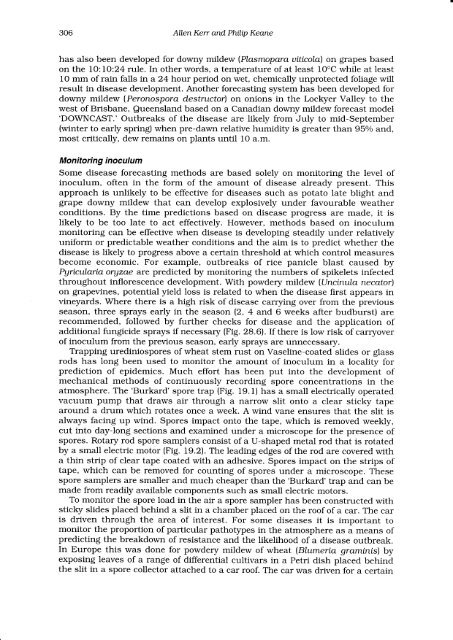PREDICTION OF DISEASE OUTBREAKS AIlen Kerr and Philip Keane
PREDICTION OF DISEASE OUTBREAKS AIlen Kerr and Philip Keane
PREDICTION OF DISEASE OUTBREAKS AIlen Kerr and Philip Keane
You also want an ePaper? Increase the reach of your titles
YUMPU automatically turns print PDFs into web optimized ePapers that Google loves.
306 ALLen <strong>Kerr</strong> <strong>and</strong> <strong>Philip</strong> <strong>Keane</strong><br />
has also been developed for downy mildew (Ptasmopara uiticoLa) on grapes based<br />
on the lO: lO:24 rule. In other words, a temperature of at least lO'C while at least<br />
lO mm of rain falls in a 24 hour period on wet, chemically unprotected foliage will<br />
result in disease development. Another forecasting system has been developed for<br />
downy mildew (Peronospora destructor) on onions in the Lockyer Valley to the<br />
west of Brisbane, Queensl<strong>and</strong> based on a Canadian downy mildew forecast model<br />
'DOWNCAST.' Outbreaks of the disease are likely from July to mid-September<br />
(winter to early spring) when pre-dawn relative humidity is greater than 95olo <strong>and</strong>,<br />
most critically, dew remains on plants until 10 a.m.<br />
Monitoring inoculum<br />
Some disease forecasting methods are based solely on monitoring the level of<br />
inoculum, often in the form of the amount of disease already present. This<br />
approach is unlikely to be effective for diseases such as potato late blight <strong>and</strong><br />
grape downy mildew that can develop explosively under favourable weather<br />
conditions. By the time predictions based on disease progress are made, it is<br />
likely to be too late to act effectively. However, methods based on inoculum<br />
monitoring can be effective when disease is developing steadily under relatively<br />
uniform or predictable weather conditions <strong>and</strong> the aim is to predict whether the<br />
disease is likely to progress above a certain threshold at which control measures<br />
become economic. For example, outbreaks of rice panicle blast caused by<br />
Pgricutaria oryzde are predicted by monitoring the numbers of spikelets infected<br />
throughout inflorescence development. With powdery mildew (UncinuLa necator)<br />
on grapevines, potential yield loss is related to when the disease first appears in<br />
vineyards. Where there is a high risk of disease carryring over from the previous<br />
season, three sprays early in the season (2, 4 <strong>and</strong> 6 weeks after budburst) are<br />
recommended, followed by further checks for disease <strong>and</strong> the application of<br />
additional fungicide sprays if necessary (Fig. 28.6). If there is low risk of carryover<br />
of inoculum from the previous season, early sprays are unnecessary.<br />
Trapping urediniospores of wheat stem rust on Vaseline-coated slides or glass<br />
rods has long been used to monitor the amount of inoculum in a locality for<br />
prediction of epidemics. Much effort has been put into the development of<br />
mechanical methods of continuously recording spore concentrations in the<br />
atmosphere. The 'Burkard' spore trap (Fig. t9.I) has a small electrically operated<br />
vacuum pump that draws air through a narrow slit onto a clear sticky tape<br />
around a drum which rotates once a week. A wind vane ensures that the slit is<br />
always facing up wind. Spores impact onto the tape, which is removed weekly,<br />
cut into day-long sections <strong>and</strong> examined under a microscope for the presence of<br />
spores. Rotary rod spore samplers consist of a U-shaped metal rod that is rotated<br />
by a small electric motor (Fig. I9.2). The leading edges of the rod are covered with<br />
a thin strip of clear tape coated with an adhesive. Spores impact on the strips of<br />
tape, which can be removed for counting of spores under a microscope. These<br />
spore samplers are smaller <strong>and</strong> much cheaper than the'Burkard'trap <strong>and</strong> can be<br />
made from readily available components such as small electric motors.<br />
To monitor the spore load in the air a spore sampler has been constructed with<br />
sticlqy slides placed behind a slit in a chamber placed on the roof of a car. The car<br />
is driven through the area of interest. For some diseases it is important to<br />
monitor the proportion of particular pathotypes in the atmosphere as a means of<br />
predicting the breakdown of resistance <strong>and</strong> the likelihood of a disease outbreak.<br />
In Europe this was done for powdery mildew of wheat (Btumeria gramtnis) by<br />
exposing leaves of a range of differential cultivars in a Petri dish placed behind<br />
the slit in a spore collector attached to a car roof. The car was driven for a certain






![[Compatibility Mode].pdf](https://img.yumpu.com/27318716/1/190x135/compatibility-modepdf.jpg?quality=85)










